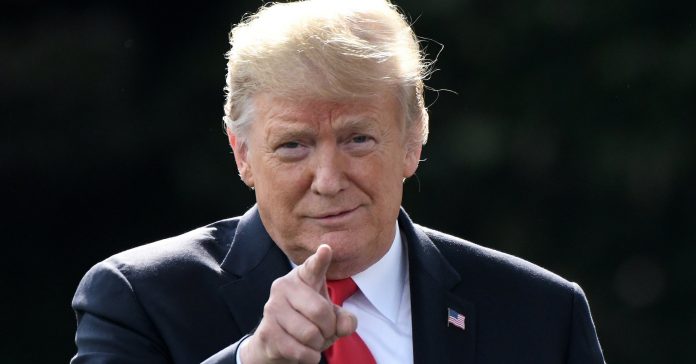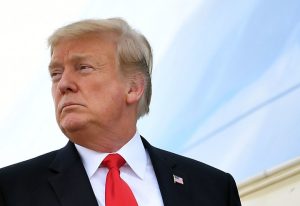
Two years in, President Donald Trump’s guaranteed immigration crackdown is barely poised to convey his expressed objective of expelling up to 3 million individuals. In any case, it has delivered something unique: expanding spending openings that the organization has mixed to fill.

President Donald Trump boards Air Force One on Tuesday as he heads to Council Bluffs, Iowa, for a campaign rally.
Since taking office, the president has over and over-arranged to clear and frequently ad-libbed changes that gave government offices a more noteworthy stake in migration implementation yet tangled their missions. The sudden arrangement shifts started self-caused emergencies that routinely required bandage arrangements significantly more costly than the present state of affairs. Also, to pay for everything, the organization pulled cash from government offices that have nothing to do with migration ― including disease look into, Head Start and the Federal Emergency Management Agency. It’s policymaking for the Trump period: surged, disordered, costly — and at last foolish.
A Tent Camp For The Price Of A Luxury Hotel
Maybe the most glaring case of the inefficiency of the White House’s methodology is the making of the tent sanctuary for vagrant kids at Tornillo, Texas. The organization had the camp quickly raised in June as a crisis measure to protect 400 unaccompanied minors and youngsters it had isolated from their families at the fringe.
The Tornillo contract should terminate in September. In any case, as the month twisted to a nearby, authorities chose to keep the office open to fathom another emergency of the organization’s own creation.
The new emergency was activated by the organization’s choice in May to start fingerprinting the grown-up supporters (regularly relatives) who tried to recover youngsters the administration had kept — and to impart that data to Immigration and Customs Enforcement.

Security officers patrol the perimeter of the tent encampment near the Tornillo Port of Entry in West Texas. It was initially built to house 400 children. Now nearly 4,000 are detained there.
Since patrons are regularly unapproved migrants themselves and in this way hesitant to be fingerprinted by government offices, the result was unsurprising: More kids are stuck in safe houses for longer timeframes.
The framework, kept running by the Department of Health and Human Services’ Office of Refugee Resettlement, is as of now lodging more than 13,000 of them — around fivefold the number of as a year prior. So as opposed to closing down the Tornillo tent camp, the Trump organization is pressing more kids into it, with plans to hold upwards of 3,800 minors.
The normal expense: $750 every night, per bed. For about a similar value, the government could pay for a choice in the room — with a perspective of Central Park — at Trump’s Manhattan inn. For consistently that the Trump organization bolts up a solitary undocumented minor in the Texas desert, it pays more than the yearly expense of putting an understudy through a state school, finish with food and lodging.
The arrangement of fingerprinting supporters and offering that data to ICE didn’t exist when Congress affirmed the HHS spending plan. Yet, the legislature as yet stays with the bill. To cover the hole, HHS reshuffled about $260 million a month ago from different parts of its financial plan, as Yahoo! News initially announced. Among the washouts in the clash of needs are tumor investigate ($13.3 million), Head Start preschool ($16.7 million) and HIV counteractive action ($5.7 million).
Inside seven days of taking office, Trump marked an official request wiping out capture needs set by the active Obama organization. Rather than concentrating on confining ongoing fringe crossers, individuals with genuine violations or the individuals who had been extradited previously, the White House liberated the office to capture any unapproved settler its specialists find. The order was clear: Arrest more vagrants.
ICE did only that. The office’s movement captures bounced 42 percent over the initial eight months after Trump took office. Migration captures hopped an extra 17 percent over the initial 75% of this monetary year, to about 120,000, ICE’s latest information appears. In excess of 33% of those individuals ICE captured had no criminal feelings, which means they wouldn’t have been captured under the Obama-period rules Trump rejected.
Aimless captures bode well for a legislator who battled as an implementation hard-liner. Be that as it may, they’re a wasteful method for expelling unapproved migrants from the nation. Individuals without genuine criminal records or extradition orders are commonly qualified for a meeting. Since the movement court overabundance has expanded by in excess of 48 percent throughout the most recent two years to 764,000 cases, it regularly takes a very long time to get new arrestees before a migration judge.
“They’re overpowering us,” Dana Leigh Marks, a representative for the National Association of Immigration Judges, told HuffPost. “The number of migration cases coming in keeps on being devastating to the court.”
Those new arrestees sitting tight for hearings are stressing the movement confinement framework. Congress a year ago showered almost 1 billion new dollars on ICE — a bonus bigger than the past six years of spending supports joined. In any case, that financial plan gave the organization sufficiently just cash to bolt up a normal of 38,000 individuals confronting extradition for every day. ICE passed up 2,000 beds in the normal day by day limit.
In this way, much the same as HHS, the Department of Homeland Security, or, in other words, organization, needed to reshuffle about $200 million a month ago to make up the deficit. The most open washout was FEMA, which lost $10 million similarly as Hurricane Florence surged toward North Carolina.
To finance detainment and expulsion activities, Homeland Security pulled $13 million from Homeland Security Investigation’s residential examination spending plan and an extra $270,000 from its worldwide tasks. The Coast Guard and Transportation Security Administration hacked up several million each.
“They’ve put the truck before the steed here,” previous ICE official Alonzo Peña said. “They will do these projects and make sense of how to pay for it a short time later.”
The Trump organization’s “zero resistance” arrangement of alluding all vagrants discovered intersection the fringe unlawfully for criminal indictment is additionally both costly and wasteful. At a normal everyday bed cost of $80 per detainee — also the expenses of judges and open protectors required to make the arrangement work — the Justice Department is burning through a huge number of dollars keeping and indicting individuals the Department of Homeland Security means to expel at any rate.
So Damn Much Money… And Not Much To Show For It
The incongruity of the Trump organization’s methodology is that, by all the most evident measurements, it has neglected to meet its objectives. With the initial seventy-five percent of this current year counted, ICE is on track to expel around 250,000 transients — well beneath the in excess of 409,000 evacuations enlisted in 2012.
You’re robbing one piece of the immigration system to feed that beast of the detention system. Those are tough decisions that Congress will be forced to make
Tracey Valerio, ICE’s former head of management.
Likewise, with one month left totally for the fiscal year, arrest for unlawful outskirt intersections remains at around 355,000. Those numbers are among the least enlisted since the 1970s. Yet, they’re up, unobtrusively, over the earlier year, demonstrating that Trump’s monstrous spending — pointed soundly at terrifying potential vagrants from attempting to cross the outskirt — isn’t working.
Congress, solidly in Republican control, has so far declined to stop the office’s indirect access extension of the settler detainment framework or its advancing prioritization of insignificant migration captures over investigative work.
“You’re ransacking one bit of the movement framework to encourage that mammoth of the detainment framework,” Tracey Valerio, ICE’s previous head of administration, said. “Those are intense choices that Congress will be compelled to make.”
DHS financing enactment winding its way through Congress proposes the arrangement is to toss still more cash at the issue. Whenever passed, Congress would scoop another quarter billion dollars into ICE one year from now — a little increment contrasted with either a year ago or to what the White House requested, yet at the same time well over some other year since 2012.
Be that as it may, until the point that that new financing bill passes, the Trump organization is left rearranging cash around to pay for its movement plan. Indeed, even Trump has needed to check his aspirations to pay for his organization’s random policymaking. A month ago, DHS yanked $26 million that Customs and Border Protection had reserved for “outskirt security fencing, foundation, and innovation” and offered it to ICE. It was cash for Trump’s guaranteed fringe divider.

















